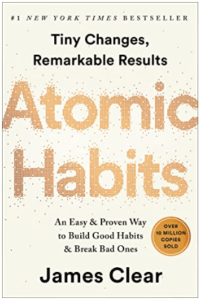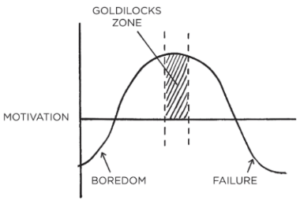The Goldilocks Rule codifies an interesting phenomenon – and how we can leverage it. This post explores what it is, and how it applies in so many areas of endeavor. The focus is on how it applies to us personally, how it applies to strategy, and how it applies to project management.
What Is the Goldilocks Rule?
 The Goldilocks Rule is derived from the story in American literature of “Goldilocks and the Three Bears“. In the story, Goldilocks tested the porridge, chairs, and the beds of the three bears to find one that felt “just right”. In her case, the porridge, chair, and bed of the smallest of the bears, baby bear, were always “just right” for her.
The Goldilocks Rule is derived from the story in American literature of “Goldilocks and the Three Bears“. In the story, Goldilocks tested the porridge, chairs, and the beds of the three bears to find one that felt “just right”. In her case, the porridge, chair, and bed of the smallest of the bears, baby bear, were always “just right” for her.
The Goldilocks Rule, also known as the Goldilocks Principle, is explained well (clearly) in the words of James Clear in his popular book, “Atomic Habits“:
“The Goldilocks Rule states that humans experience peak motivation when working on tasks that are right on the edge of their current abilities. Not too hard. Not too easy. Just right.”
 While people may experience peak motivation for a period, Clear emphasizes that eventually boredom will set in, and we need to find ways to motivate through that. Routine is inevitable, even in “just right” situations. The greatest success still comes to people that keep working even after the excitement has worn off.
While people may experience peak motivation for a period, Clear emphasizes that eventually boredom will set in, and we need to find ways to motivate through that. Routine is inevitable, even in “just right” situations. The greatest success still comes to people that keep working even after the excitement has worn off.
The idea is simple, but it has wide application. The post focuses on the application of the Goldilocks Rule personally, in organizational strategy, and project management.
Personal Application of the Goldilocks Rule
 The Goldilocks Rule applies to us personally in terms of improving our performance, building strong habits, and keeping us motivated. Let’s take a look at each of these three.
The Goldilocks Rule applies to us personally in terms of improving our performance, building strong habits, and keeping us motivated. Let’s take a look at each of these three.
- Improving personal performance – Whenever we want to improve our performance at anything, we need to find conditions where we are challenged to stretch our capabilities – but not too far. For example, our girls played tennis growing up, and it was always optimal for them to play with someone at or a little above their level of play – to enable them to stretch their abilities and improve – but not too far as to be discouraging.
- Building strong habits – In school, work, and personal activities, we want to build habits that will best service us in our goals and aspirations. James Clear, in “Atomic Habits”, provides many techniques to increase our chances of success in building good habits – and eliminating bad ones. One of the underlying principles is making it “easy” – thus increasing our chances of success. The Goldilocks Rule is an extension of this – finding situations that have just enough challenge to engage us fully, and not too much that would discourage and demotivate us.
- Keeping us motivated – Clear also talks about maintaining motivation for the long hull. For example, I seek variety in a way that breaks things up and keeps them more interesting for me. But James Clear points out that with any habit and with any pursuit, boredom at some point is impossible to avoid. I have coped by trying to add variety and keep it fresh. Clear asserts that ultimately anyone who has reached a high level of competence at anything has found a way to power through the seeming monotony that eventually comes in every pursuit. It takes patience and consistency – sticking to good habits.
The road to success is built on the foundation of these three pillars: finding ways to stretch our current abilities to improve personal performance, finding ways to build strong habits that will support us in our personal goals, and coping with the long term – the eventually drudgery that finds its way into our activities, and finding ways to “keep on keepin’ on”.
The Goldilocks Rule Applied to Strategy
The Goldilocks Rule “grounds” us in reality by bounding our enthusiasm to help us devise strategies that are most likely to bring success.
Here are five specific strategic areas in which the Goldilocks Rule can positively impact our strategic thinking:
- Finding the Right Level of Ambition – This is the most general on the list, but sets the tone. As with application in personal life, it guides us to seek out goals that are attainable, but not necessarily easy. The principle focuses us on a level of ambition that is both challenging and achievable. In addition to having external conditions more in our favor, this approach can be more motivating to keep employees engaged in making steady progress toward strategic goals and objectives.
- Identifying the Right Market Niche – In many ways, success is determined by what we choose to do as much as how we do it. As with Porter’s three generic strategies, the Goldilocks Rule has a way of putting up guideposts. If we stay within those guideposts – in areas that seem “just right” – we will define our target markets neither too broadly nor narrowly. This will best enable us to achieve competitive, comparative, and absolute advantage against competitors.
- Developing Appropriate Technologies – Inside a company we have a certain level of technical skills. We can grow that level – but need to be careful how far both vertically and horizontally. And we can build our capabilities incrementally – one “just right” increment at a time. This will impact our strategies both on the product and operations sides.
- Addressing the Right Operational Issues – Companies tend to excel at things that jive with some combination of capabilities of people, capabilities of physical assets, and capabilities for innovation and invention. While it’s great to push outside the comfort zone, it’s also wise to not go too far outside to increase our chances of operational success.
- Making Balanced Financial Decisions – Making financial decisions is a great crossroads between risk and reward, or being conservative or aggressive. We can try to find the “just right” point by estimating and forecasting more realistically, making incremental decisions that build funds for later use, and curb our ambitions with appropriate investments.
Overall, the Goldilocks Rule can help us to zero in on that place where, in all areas of endeavor, risks and rewards are relatively balanced. This results in optimal performance by people, and generally will result in optimal chances of success.
The Goldilocks Rule and Project Management
The Goldilocks Rule applies as strongly on the implementation side as the strategic side.
Here are five areas of project management that involve finding just the right mix of risk and reward to move the project forward:
- The Triple Constraint – We seek to work with the constraints of scope, cost, and time to deliver a project of the target quality level. But there is a lot of room for “negotiation” there. First, the constraint forces us to reduce in one constraint if we add in another. Second, there may be some wiggle room in the quality of the product outcome that will allow for some additional optimizing of the constraints. The idea is to find the way that feels “just right”. Third, there are other similar triple constraints such as the Engagement Triple Constraint and the Benefits Triple Constraint where we can look for what seems “just right”.
- Level of Detail – What level of detail is needed in product design? How about documentation? What about requirements? The answer is different for every project, and for every type of project. The key is to recognize that there is no single right answer that applies everywhere, and that you need to use your skills, those of your team, and the input of stakeholders to find that sweet spot that is the “just right” level of detail.
- Managing Stakeholder Expectations – Our natural tendency is to oversell. That means exaggerating benefits, over promising on delivery schedules, and under estimating costs. That’s where the discipline of project management helps – and where the Goldilocks Rule can provide some extra push. Recognize the realistic space that is both achievable and still delivers enough of what stakeholders want.
- Matching the Right People to the Job – We need people that have the right skill and experience – but that also thirst for the challenge of the job. This is another balancing act. You need to allow people to take some calculated risks – but need to have the downside covered when things go wrong.
- Motivating the Team – The team needs to have a collective motivator that drives them with a common purpose. Sometimes that’s easy – when there is a particularly exciting project using a new technology, an innovative application, working in some particularly interesting domain,…or an objective that is particularly alluring. However, all projects are not that way, and many can be downright mundane. As project leaders, we need to find the purpose behind the project that can rally the troops, and find ways to connect that purpose to each individual’s personal motivational factors.
Finding that sweet spot that feels “just right” is a core part of project management.
Conclusion and Further Resources
This post has discussed the Goldilocks Rule – what it is, how it applies to us personally, how it applies to strategy, and how it applies to project management.
Can you share a story of where the Goldilocks Rule applied to you in one of these domains?
If you have not read it, I strongly encourage James Clear’s immensely practical book “Atomic Habits“.
Here is a short video, “A Science Based Rule to Stay Motivated in Life” by Vihan Chelliah, that nicely encapsulates the basic concept of the Goldilocks Rule:

1 thought on “Managing Strategic Projects and the Goldilocks Rule”